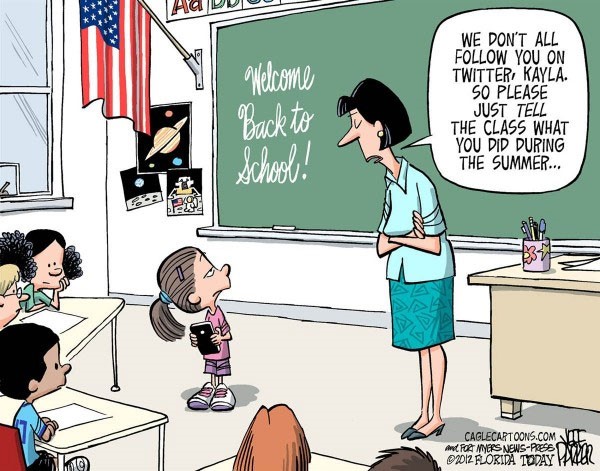#LearningUsingSocialMedia
Adapted from: http://cristianaziraldo.altervista.org/debating-social-media/
---------------------------------------------------------------------------------
Bennet, et al. 2012 "Implementing Web 2.0 technologies in higher education: a collective case study" Computers & Education 59 (2012) 524–534
Manca & Ranieri, "Is it a tool suitable for learning? A critical review of the literature on Facebook as a technology-enhanced learning environment." Journal of Computer Assisted Learning (2013), 29, 487–504
Warschauer & Grimes "Audience, Authorship, and Artifact: The Emergent Semiotics of Web 2.0"
Annual Review of Applied Linguistics (2007) 27, 1–23.
----------------------------------------------------------------------------------
Our class discussion on the usage of social media (e.g., Facebook, Twitter, Instagram) in the classroom greatly highlighted the importance of understanding the appropriateness of a tool to a task.
We learned from Bennet, et al. that even using the same activity (e.g., posting photos on Flickr as a class exercise or writing a blog) can lead to varying degrees of success. The same can be said of other technologies that have emerged from the Web 2.0 with the rise of user-generated content. The theme of a "square peg into a round hole" appeared several times (i.e., forcing the usage of tool for a task it was not designed for), and highlights the need that as instructors, we need to critically think about how to use the plethora of technology now available.
Manca & Ranieri propose the possibility of Facebook as a technology-enhanced learning environment. My knee-jerk reaction upon reading this was that this was not a good idea. It would mix people's social and academic lives, and it would introduce so much uncertainty in the student-teacher relationship (e.g., do you friend the student or not?). As someone with more STEM leanings, I was also hard pressed to think of times at which Facebook would be appropriate. However, I thought the in-class example of using Facebook to facilitate intercultural learning between students was fantastic. Because Facebook facilitates more informal social networking, it was well-suited to facilitating a more natural interaction between students of different cultures. This was a great example to enforce that while you need to think critically about the appropriateness of a tool to a task, it is also important to keep an open mind.
Although this was not discussed in class, I was also intrigued by the article from Warschauer and Grimes about the underlying social context behind social media. For example, several studies found a correlation between cultures with high power differentials and low frequency of editing of Wikipedia. That is, if a hierarchy of authority was more ingrained in a culture, people tended to edit Wikipedia less. I thought this was a striking observation- it implies that in-class activities cannot be treated as closed systems between student and teacher, but that other complex, confounding variables are at play. I wonder, have you as the reader observed this to occur in your experience?
I was really excited about the emergence of Web 3.0. Web 1.0 was mostly focused on building the internet (e.g., building the protocols, interface, formatting) and generating content. Web 2.0 shifted towards user-generated content with the expansion of the internet to mobile devices. Now, it is predicted, the internet will evolve again into Web 3.0, a more adaptive and intelligent form of the the internet, which includes but is not limited to: semantic web, microformats, natural language search, data-mining, machine learning, recommendation agents. These all (to varying degrees) stem from the manipulation of huge amounts of data and extracting useful information. While the technical details would be impossible to cover in the length of the class period, I found this upcoming stage of the web to be exciting. What do you think? How do you think it will affect the classroom? Will this redefine how we teach or what the role of the teacher is?






